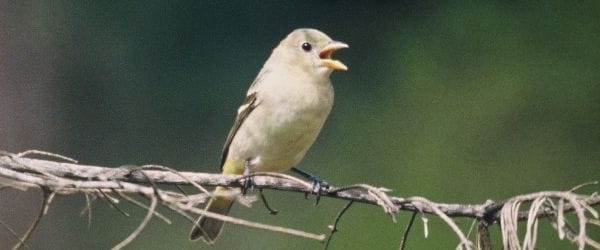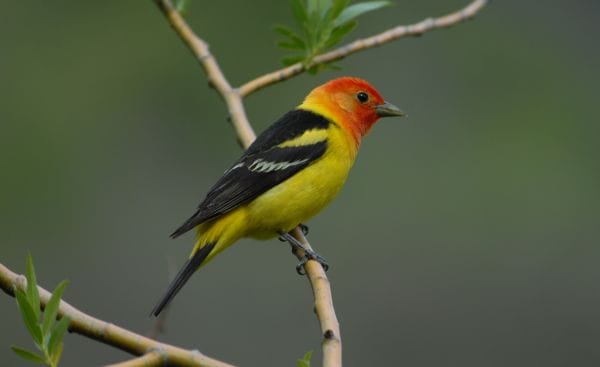The first time I saw a Western Tanager, it was in New York. In Central Park, to be exact.
It was exciting — to a degree. A lifer is always exciting, and a vagrant is always exciting too. Moreover, at the time I had no inkling that I’d be moving to Montana in two and a half years – in fact, it would be nearly a year before I decided to go to grad school and entertained the notion of leaving New York at all. So for all I knew, this would be the only Western Tanager I’d see for a long time.
But the bird itself was a little bit of a let-down. I’m capable of enjoying birds that others might call drab, but for some reason this olive and black thing just didn’t do much for me. Maybe it was the fact that only a dull wing bar and dark back separated it from the female and young male Scarlet Tanagers that I saw regularly. Or maybe, after my experiences with the Scott’s Oriole in Union Square earlier that year, the Tanager just seemed unconfiding and hard to see.

When you could see it, it looked sort of but not exactly like this.
After that, I didn’t think much, if at all, about Western Tanagers for three years.
Then, in late May, I was walking up the block and spotted a brilliant bird foraging quite low in a streetside tree. I didn’t have my binoculars, but it didn’t take long to suss out that it was a bright, shiny breeding-plumaged male Western Tanager.

And that, that was exciting. Maybe there’s nothing wrong with a little purely aesthetic appreciation after all.
I pointed the bird out to my companion, who isn’t a birder but could certainly appreciate the ‘bright’ and ‘shiny’ aspects. And then we went on our way to dinner.
Over the following month, as migration trailed off and breeding season started in earnest, I was seeing these newly-minted Cardinal cousins everywhere. Parks, street trees, the riverfront trail. And every time, it was exciting. Even though on the whole, this species seems more inclined to get close than the Scarlet and Summer Tanagers I was used to in New York. Even though I now have no new check mark to make on my list for it.
I used to worry that getting too excited about rarities and vagrants would make me take common birds for granted, and this is a worry I’ve seen expressed by other soul-searching birders. But I’m not jaded about Western Tanagers – I’m delighted that this beautiful bird is common where I am. Not only because it’s good for the species, and good for the non-birders who stop for a moment and appreciate it. Because it’s good for me to see a familiar bird that makes me smile.
Tanager photos by Lee Karney and David Mencke, respectively, courtesy as usual of the National Fish and Wildlife Service.












At last there is a Western Tanager on 10000 Birds! High time too.
Cool bird and plumage. That change is amazing.
I once had a comparable moment, just upside-down:
I searched for a vagrant Pectoral Sandpiper in Germany for years to no avail, and I got quite frustrated about it because that’s the one species of vagrant shorebird that everybody who is three years into birding seems to find.
Then I saw plenty of them where they are expected to be, in Ontario during a trip in May 2005.
And just two months after returning to Germany, I found one near my hometown on the Baltic Sea.
Of course it wasn’t as exciting as finding a life Pec in Germany would have been. But the entire context gave this one vagrant a personal meaning beyond the pure aspect of having finally found one. It made this bird a very special bird.
And special birds are the best birds.